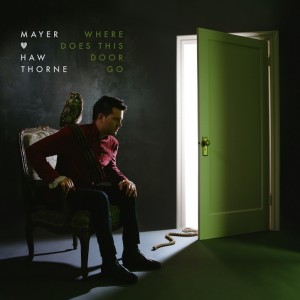 DJ-turned blue-eyed soul stirrer Mayer Hawthorne is back with his third studio LP, Where Does this Door Go? Following his 2009 debut (A Strange Arrangement) for Stones Throw, Hawthorne jumped to major Universal Republic for his 2011 follow-up. That album (How Do You Do) brought significant buzz and critical notoriety. Part of what made How Do You Do so appealing was the fact that it was a logical creative step from Hawthorne’s debut. Both are imminently soulful; yet in contrast to the subdued seduction of A Strange Arrangement, How Do You Do generally stepped away from balladry in favor of dance floor soul, no doubt part of Hawthorne’s very DNA, having grown up in Detroit.
DJ-turned blue-eyed soul stirrer Mayer Hawthorne is back with his third studio LP, Where Does this Door Go? Following his 2009 debut (A Strange Arrangement) for Stones Throw, Hawthorne jumped to major Universal Republic for his 2011 follow-up. That album (How Do You Do) brought significant buzz and critical notoriety. Part of what made How Do You Do so appealing was the fact that it was a logical creative step from Hawthorne’s debut. Both are imminently soulful; yet in contrast to the subdued seduction of A Strange Arrangement, How Do You Do generally stepped away from balladry in favor of dance floor soul, no doubt part of Hawthorne’s very DNA, having grown up in Detroit.
Where does this Door Go picks up where How Do You Do left off, with the soulfully funky opener “Backseat Lover,” oozing Hall and Oates influence from every pore. In truth, “Backseat Lover” is an effective opener. Sure, it is highly danceable and a laced with an earworm of a hook (not unlike “The Innocent,” “Wine Glass Woman,” and “Robot Love” elsewhere on the album). But more importantly, “Backseat” finds Hawthorne attempting to replicate prior successes, while opting to not take a particularly significant creative step forward, which can in fact be said for the entire LP.
This doesn’t indicate that Where Does this Door Go lacks stylistic variety, or even that it’s a poor album. Along with the dancier cuts mentioned above, Hawthorne does not shy away from the soul balladry that so heavily populated his first LP (“Where Does this Door Go” and “All Better,” for example). Beyond that, the midtempo soul ballad “Allie Jones” incorporates a reverb-heavy reggae rhythm track counterbalanced by Hawthorne’s falsetto, a vocal trademark executed with greater confidence in each of Hawthorne’s successive albums. Other tracks serve up soul-funk rhythms sprinkled with pop aesthetics, perhaps a conscious attempt to work against the restrictive perception of being solely a throwback artist. Tracks such as “Corsican Rose” and lead single “Her Favorite Song” evince the most notable nods to contemporary pop aesthetics, while the enlistment of Kendrick Lamar for the slinky “Crime” could be a similarly strategic move (though the track would frankly be stronger without Lamar’s awkwardly staccato delivery).
Whether Hawthorne can break through to some measure of mainstream success will be dependent on how far into this direction he’s willing to bend. Where Does this Door Go makes sensible compromises in this regard, but is unlikely to give Hawthorne that great push over the edge into wider commercial success. On the purely artistic side of the spectrum, Hawthorne’s third LP is a mixed bag that spotlights the Detroit soulster at his very best (“Backseat Lover,” “The Innocent,” ‘The Stars are Ours”), but also slumps into competent, yet not particularly compelling tunes (“Her Favorite Song,” “All Better,” “Crime”). In the wake of How Do You Do, producing another solid, fantastic start-to-finish disc would be against the odds; Hawthorne had a lot to live up to in crafting his third album. Ultimately, Where Does this Door Go is far from a disappointment, but there simply isn’t enough compelling material here to make the album a standout in Hawthorne’s thus far impressive yet brief recording career.
Grade: B-
[amazon-product]B00D6ZCW4I[/amazon-product]

